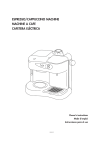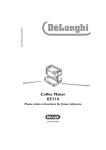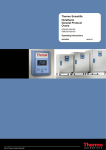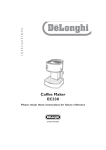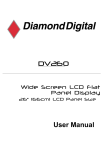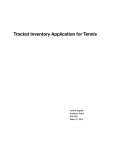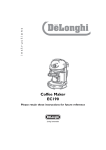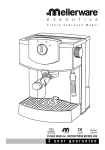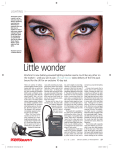Download DeLonghi EC610 Instruction manual
Transcript
GB OK 16-12-2002 11:21 Pagina 12 GB Thank you for choosing this coffee machine. To get the very best out of your new coffee machine it is advisable to read these instructions before using the appliance. This is the only way to ensure optimum results and maximum safety. • DESCRIPTION OF THE APPLIANCE • The following terms are used throughout the instruction manual • 1 2 3 4 5 6 7 8 9 10 11 12 13 14 15 16 17 18 19 20 21 22 23 24 25 Cup warmer Compartment for accessories Steam outlet lever Level indicator Power cord Water tank “Cappuccino” nozzle Anti-scalding guard Steam outlet tube Pressure gauge (if fitted) ON/OFF switch Coffee dispenser switch Steam switch ON/OFF indicator light Coffee-ready indicator light Steam-ready indicator light Filter for coffee with frother Filter holder for coffee Coffee press Boiler outlet Filter for pods (if fitted) Filter holder for pods (if fitted) Mesuring Drip tray Grid for cups SAFETY WARNINGS • This machine has been built to “make coffee” and to “reheat beverages”; please be careful to avoid burns from the sprays of hot water or steam and avoid any improper use. • When the appliance is in use, do not touch any of the machine’s hot surfaces. • After unpacking, make sure that the machine is complete and undamaged. In case of doubt, do not use the appliance and seek the advice of a qualified service professional. • Packaging materials (plastic bags, foam polystyrene, etc.) should not be left within the reach of children as this could be a potential source of danger. • This appliance is to be utilised for domestic use only. 12 • • • • • Any other use is to be considered improper and therefore, dangerous. The manufacturer takes no responsibility for damage derived from improper use. Never touch the appliance with wet or damp hands. The appliance is not intended for use by young children or infirm persons without supervision. Young children should be supervised to ensure that they do not play with the appliance. In case of breakdown or malfunctioning, turn off the appliance immediately and do not touch it. For repairs, please contact a Service Centre authorized by the manufacturer and request the use of original replacement parts only. The lack of respect for this point may compromise the safe use of the appliance. The power supply cable of this appliance must never be replaced by the user, because its replacement requires the use of special tools. If the cable should become damaged, or in case it needs to be replaced, please go to a Service Centre authorized by the manufacturer. When the appliance is not in use, turn off and disconnect the plug from the socket. As with any electrical appliance, whilst the instructions aim to cover as many eventualities as possible, caution and common sense should be applied when operating your appliance, particularly in the vicinity of young children. INSTALLATION • Place the coffee maker on flat work surface at a safe distance from taps and sinks. • Check that the voltage corresponds to that indicated on the appliance rating plate. The appliance must always be connected to a well-earthed socket rated at 10 A minimum. The manufacturer is not liable for damage caused by inadeguate earthing of the appliance. • n the event of incompatibility between the plug on the appliance and the socket, have the plug replaced with another of the right type by a qualified professional. If the cable is damaged or requires replacing, contact a service centre authorised by the manufacturer only. • Never install the machine in an environment that can reach a temperature less than or equal to 0°C (if the water in it freezes, the coffee maker may be damaged). GB OK 16-12-2002 11:21 Pagina 13 HOW TO PREPARE ESPRESSO COFFEE FILLING THE WATER TANK: Remove the water tank by pulling it sideways, at the same time lifting the tubes (fig. 1). Rinse the water tank and fill with fresh water up to the upper mark (fig. 2). Inspection of the water level is facilitated by a ball-shaped float. Replace the water tank in its housing, ensuring that the tubes are immersed in the water. A simpler way of filling the water tank is to pull it out just enough to be able to pour in water directly from a jug. Remember to clean the water tank regularly. PREHEATING THE COFFEE MACHINE To obtain espresso coffee at the right temperature, the coffee maker must be preheated. Press the ON/OFF switch (fig. 3) at least half an hour before making the coffee, making sure the filter holder is attached to the appliance (check that the steam release knob is closed). To attach the filter holder, place it under the boiler outlet with the handle towards the left (fig. 4). Push upwards and at the same time turn the handle as far to the right as possible. To avoid leaks of water, rotate firmly. After half an hour, make coffee following the instructions of the next paragraph. Alternatively, for a faster operation, proceed as follows: 1.Press the ON/OFF switch (fig. 3). Attach the empty filter holder (without coffee) to the machine 2.Position a cup under the filter holder. Use the same cup that the coffee will be served in, so that it may be preheated. 3.Wait until the “OK” light comes on (fig 5) and press the delivery switch (fig 6). Allow water to flow until the orange “OK” light goes out, then stop the flow of water by pressing the delivery switch again. 4.Empty the cup, wait until the “OK” pilot light comes on again and repeat the whole operation one more time. (It is normal for a small and harmless puff of steam to be given off when removing the filter holder). HOW TO PREPARE ESPRESSO COFFEE USING THE FILTER HOLDER FOR GROUND COFFEE 1.After preheating the appliance as described in the above paragraph, insert the ground coffee filter with frother into the filter holder, making sure the tab is correctly inserted into the housing as shown in fig. 7. 2.To prepare a single coffee, fill the filter with a level measure of ground coffee, about 7 g (fig. 8). To prepare two coffees, use the filter and fill with two loosely filled measures of ground coffee (about 6+6 g). Fill the filter in small doses to prevent the ground coffee from overflowing. IMPORTANT: For correct operation, before adding the ground coffee to the filter holder, make sure the filter is free from ground coffee from the previous infusion. 3.Distribute the ground coffee uniformly and press it lightly with the pressing pad (Fig. 9). NOTE:Pressing the coffee is very important in order to prepare a food coffee. However if you press too hard, coffee will come out slowly and cream will be of a dark colour. If you press to light, coffee will come out too fast and cream will be a very light color. 3. Remove any excess coffee from the rim of the filter holder and attach the filter holder to the appliance. Rotate firmly (fig. 4) to avoid leaks of water. 4.Place the pre-heated cup or cups on the drip tray, under the filter cup spouts fig 10). SIt is recommended to warm the cups before making the coffee, by rinsing them in a little hot water or placing them on top of the machine (Fig. 29). 5.Wait until the “OK” light comes on (fig 5) then press the coffee delivery switch (fig. 6) until the desired quantity of coffee is obtained. To stop the flow, press the coffee delivery switch again (fig. 6). 6.To detach the filter holder, turn the handle from right to left. To avoid any splashing, do not detach the filter holder while the machine is dispensing coffee. 7.To remove the used coffee, hold the filter locked with the special lever that is built into the handle and let the coffee fall out by knocking the overturned filter holder (Fig. 11). 8.To turn off the coffee maker, press the ON/OFF switch (fig. 3). ATTENTION: The first time that coffee is prepared, it is necessary to wash all of the accessories and the internal circuits of the machine, preparing at least five coffees without using the ground coffee. 13 GB OK 16-12-2002 11:21 Pagina 14 HOW TO PREPARE COFFEE USING THE FILTER HOLDER FOR PODS (if fitted) 1.Preheat the machine as described in the ‘Preheating the Coffee Machine’ section, making sure to leave the filter holder attached to the unit. Following this procedure ensures that the coffee is delivered at a hotter temperature. 2.Press the filter holder button and insert the pod into the filter (fig 12). Always follow the instructions on the package of the wafers for the correct positioning of the wafer in the filter. Note: Use pods which conform to the ESE standard: this will be indicated on the packaging by the following symbol: The ESE standard is a system accepted by the leading coffee pod manufacturers, and allows espresso coffee to be prepared simply and without any mess. 3.Attach the filter holder onto the machine, moving from left to right (fig 4). Note: to ensure effective closure and avoid leaks of water from the rim of the filter holder, you are recommended to grease the bottom of the lateral tabs from time to time with butter or oil (as shown in fig. 13). IMPORTANT: Should the coffee holder for pods be used after one for ground coffee, it’s necessary to clear the ground coffee remained in the espresso boiler outlet (fig. 13). This cleaning operation is necessary in order to avoid water leackeges from the coffe holder for pods whele coffee is being preposed. 4.Proceed as in points 4, 5 and 6 of the previous paragraph (how to prepare espresso coffee using the filter holder for ground coffee). 5.To remove the pod, press the button on the filter holder and simply lift the pod out 6.To turn off the coffee maker, press the ON/OFF switch (fig. 3). USING THE PRESSURE GAUGE (if fitted) In order to obtain a good espresso coffee, it is necessary that the delivery take place with the boiler at its optimum pressure. This pressure is attained when the pointer of the pressure gauge is within the greycoloured section (fig. 13). 14 HOW TO MAKE CAPPUCCINO 1.Prepare espresso coffee, using cups that are large enough for cappuccinos 2.Press the steam switch (fig. 16) and wait until the “OK” light comes on (fig. 5) to indicate that the boiler has reached the ideal temperature for producing steam. 3.In the meantime, fill a container with approximately 100 gr. of milk for each cappuccino to be prepared. The milk must be cold from the refrigerator (not warm!). In choosing the container, bear in mind that the volume of the milk will increase by 2 or 3 times. NOTE: We suggest you used semi-skimed milk at refrigerator temperature. 4.Position the container with the milk in it under the milk frother (fig 18). 5.Immerse the cappuccino maker nozzle about 5 mm deep into the milk and turn the steam knob in an anti-clockwise direction (fig. 18) (by turning the knob to a greater or lesser extent, it is possible to vary the quantity of steam that comes out from the cappuccino maker). At this point, the milk will begin to increase in volume and to appear frothy. 6.When the volume of the milk has doubled, fully immerse the milk frother and continue heating the milk (Fig. 19). Once the desired temperature has been reached (the ideal temperature is 60°C), stop the delivery of steam by turning the steam knob in a clockwise direction and at the same timepressing the steam knob (fig. 16). 7.Pour the frothed milk into the cups containing the espresso coffee. Your cappuccino is now ready. Add sugar to taste and, if desired, sprinkle a little powdered chocolate on top of the froth. Note: to prepare more than one cappuccino, first make all the coffees then at the end prepare the frothed milk for all the cappuccinos. IMPORTANT: always clean the milk frother and steam nozzle immediately after use. Proceed as follows: 1.By turning the steam knob (fig. 18), allow a little steam to come out for a few seconds. Then close firmly by turning clockwise. 2.Hold the upper part tight with one hand and use your other hand to unscrew the cappuccino maker, rotating it in a clockwise direction, and remove it from the nozzle (fig. 20). 3.Check that the 3 holes shown in fig. 21 are not blocked. If necessary, clean them with the help of a pin. 4.Clean the steam delivery tube, being careful to avoid being burnt. 5.Screw the milk frother back on. GB OK 16-12-2002 11:21 Pagina 15 PRODUCING HOT WATER 1.Turn on the coffee unit by pressing the ON/OFF switch (fig. 3). Wait until the ‘OK’ pilot light comes on (fig. 5). 2.Position a container under the cappuccino maker. 3.Press the coffee delivery switch and at the same time turn the steam knob in an anti-clockwise direction; hot water will come out from the steam tube. 4.To stop the flow of hot water, turn the steam knob in a clockwise direction and press the coffee delivery switch. CLEANING AND MAINTENANCE Before carrying out any cleaning operations of the exterior parts, switch the machine off, remove the plug from the socket and leave the machine to cool. CLEANING THE FILTER HOLDER FOR GROUND COFFEE About every 300 coffees, clean the filter holder for ground coffee as follows: • Remove the filter with the frother; • Clean the inside of the filter holder. Never wash in a dishwasher. • Unscrew the cap of the frother (fig. 22) by rotating in the direction indicated by the arrow on the cap. • Remove the frother from the container by pushing it from the cap end. • Remove the gasket. • Rinse all components and clean the metal filter thoroughly in hot water using a brush (fig. 23). Make sure the holes in the metal filter are not blocked. If necessary, clean with a pin (see fig. 24). • Replace the filter and gasket on the plastic disk as shown in figure 25. Make sure to insert the pin on the plastic disk into the hole in the gasket indicated by the arrow in fig. 25. • Replace the assembly into the steel filter container (fig. 26), making sure the pin is inserted into the hole in the support (see arrow in fig. 26). • Finally, screw on the cap. Failure to clean as described above invalidates the guarantee. CLEANING THE FILTER HOLDER FOR PODS (IF SUPPLIED) About every 300 coffees, clean the filter holder for pods as follows: • Push the filter holder button, remove the filter (fig. 27) and the frother if fitted. Clean the inside of the filter holder. Never wash in a dishwasher. • Clean the filter thoroughly in hot water using a brush. Make sure the holes in the metal filter are not blocked. If necessary, clean with a pin (see fig. 23). • Replace the filter. Failure to clean as described above invalidates the guarantee. CLEANING THE ESPRESSO BOILER OUTLET At least twice a year, the espresso boiler outlet must be cleaned as follows: • check that the coffee machine is not warm and the plug is detached from the mains; • using a screwdriver, unscrew the screw that holds the outlet of the espresso boiler (fig. 28); • clean the boiler with a damp cloth (fig. 14); • clean the outlet thoroughly in hot water using a brush. Make sure the holes are not blocked. If necessary, clean with a pin (fig. 24). • rinse the outlet under the tap, still scrubbing it; • replace the outlet of the espresso boiler, making sure the gasket is correctly repositioned. Failure to clean as described above invalidates the guarantee. OTHER CLEANING OPERATIONS 1. Do not use solvents or detergents in cleaning the coffee maker. Use a soft, damp cloth. 2. Remove the drip-trays, empty them and wash them periodically ATTENTION: during cleaning, never immerse the unit in water – it is an electrical appliance. DESCALING It is advisable to clean the calcium from the machine every 300 cups of coffee. It is recommended that specific (store-bought) products for descaling of espresso coffee machines be used. If such products are not available, it is possible to proceed as follows: 1.Fill the tank with water using 1 liter of water; 2.Dissolve 2 spoonfuls (about 30 grams) of citric acid in the water (available from chemists); 3.Press the ON/OFF switch and wait that the OK pilot lamp switches on. 4.Check that the filter holder is not attached and place a container under the outlet of the machine; 5.Press the coffee delivery switch, let the water flows for half water tank and turn the steam lever to let some water to flow out from the steam tube. Then press the coffee delivery switch to interrupt. 6.Allow the solution to act for about 15 minutes, then start up the flow again until the tank is completely empty; 7.To eliminate the remains of the solution and the calcium, rinse the tank well, fill it with clean water and replace. press the coffee delivery switch to 15 GB OK 16-12-2002 11:21 Pagina 16 empty the water tank. 8.Press the delivery switch and repeat the last step one more time. Repairs for malfunctioning caused by problems of calcium build-up are not covered by the guarantee if the descaling process described above is not carried out regularly. 16 GB OK 16-12-2002 11:21 Pagina 17 PROBLEM Espresso coffee no longer comes out. POSSIBLE CAUSES • Lack of water in the tank. • The holes in the filter holder are blocked. • The outlet of the espresso boiler is blocked. • The tank is badly inserted and the valve at the bottom is not open. • Fill the water tank. • Clean the holes in the spouts. Espresso coffee drips from the edges of the filter holder, instead of from its holes. • The filter holder is badly inserted. • Attach the filter holder correctly by rotating firmly as far as it will go. • Have the espresso boiler gasket replaced at an Service Centre • Clean the holes in the filter holder. The espresso coffee is cold. • The ‘OK’ pilot light was not on when the coffee delivery switch was pressed. • The preheating was not carried out. • The gasket of the espresso boiler has lost elasticity. • The holes in the filter holder are blocked. • The cups were not preheated. The pump is too noisy. The coffee cream is lightcoloured (the coffee comes out quickly from the spout). The coffee cream is dark (the coffee comes out slowly from the spout). • Clean as indicated in the “Cleaning the espresso boiler outlet” section. • Press the tank lightly so as to open the valve at the bottom. • Wait until the OK pilot light comes on. • Carry out the preheating as indicated in the “Preheating the coffee unit” section. • Preheat the cups by rinsing them in hot water. • The water tank is empty. • Fill the tank. • The tank is inserted wrongly and the valve at the bottom is not open. • Press the tank lightly so as to open the valve at the bottom. • The ground coffee has not been pressed enough. • The quantity of ground coffee is scarce. • The coffee is not ground finely enough. • Tamper the ground coffee down more. • Increase the quantity of coffee. • The ground coffee is too tightly pressed. • The quantity of ground coffee is too much. • The espresso boiler outlet is blocked. • Press the coffee less. • The coffee is too finely ground. • Only use coffee specifically ground for espresso coffee machines. • Decrease the quantity of ground coffee. • Clean the outlet as described in “Cleaning the espresso boiler outlet” section. • Only use coffee specifically ground for espresso coffee machines. The coffee has an acidic taste. • The unit was not sufficiently rinsed after the descaling process procedure. • Rinse the unit as described in the “descaling” section. The milk does not froth when making a cappuccino. • The milk is not cold enough. • Always use milk at refrigerator tem perature. • Carefully clean the pinholes in the milk frother • The cappuccino maker is dirty. 17 SOLUTION






